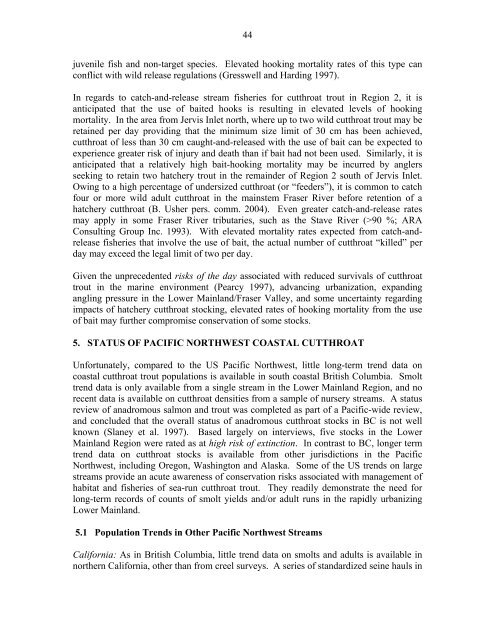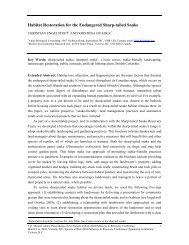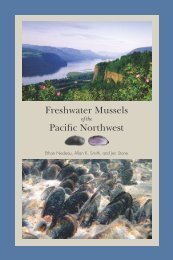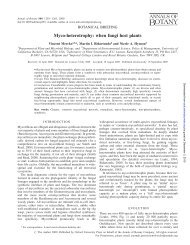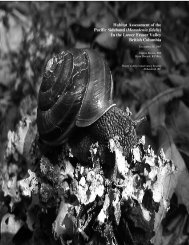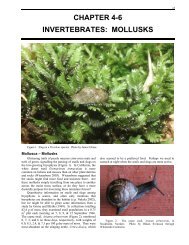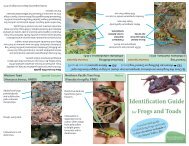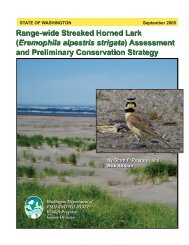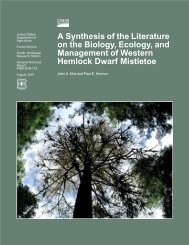Coastal Cutthroat Trout as Sentinels of Lower Mainland Watershed ...
Coastal Cutthroat Trout as Sentinels of Lower Mainland Watershed ...
Coastal Cutthroat Trout as Sentinels of Lower Mainland Watershed ...
You also want an ePaper? Increase the reach of your titles
YUMPU automatically turns print PDFs into web optimized ePapers that Google loves.
44juvenile fish and non-target species. Elevated hooking mortality rates <strong>of</strong> this type canconflict with wild rele<strong>as</strong>e regulations (Gresswell and Harding 1997).In regards to catch-and-rele<strong>as</strong>e stream fisheries for cutthroat trout in Region 2, it isanticipated that the use <strong>of</strong> baited hooks is resulting in elevated levels <strong>of</strong> hookingmortality. In the area from Jervis Inlet north, where up to two wild cutthroat trout may beretained per day providing that the minimum size limit <strong>of</strong> 30 cm h<strong>as</strong> been achieved,cutthroat <strong>of</strong> less than 30 cm caught-and-rele<strong>as</strong>ed with the use <strong>of</strong> bait can be expected toexperience greater risk <strong>of</strong> injury and death than if bait had not been used. Similarly, it isanticipated that a relatively high bait-hooking mortality may be incurred by anglersseeking to retain two hatchery trout in the remainder <strong>of</strong> Region 2 south <strong>of</strong> Jervis Inlet.Owing to a high percentage <strong>of</strong> undersized cutthroat (or “feeders”), it is common to catchfour or more wild adult cutthroat in the mainstem Fr<strong>as</strong>er River before retention <strong>of</strong> ahatchery cutthroat (B. Usher pers. comm. 2004). Even greater catch-and-rele<strong>as</strong>e ratesmay apply in some Fr<strong>as</strong>er River tributaries, such <strong>as</strong> the Stave River (>90 %; ARAConsulting Group Inc. 1993). With elevated mortality rates expected from catch-andrele<strong>as</strong>efisheries that involve the use <strong>of</strong> bait, the actual number <strong>of</strong> cutthroat “killed” perday may exceed the legal limit <strong>of</strong> two per day.Given the unprecedented risks <strong>of</strong> the day <strong>as</strong>sociated with reduced survivals <strong>of</strong> cutthroattrout in the marine environment (Pearcy 1997), advancing urbanization, expandingangling pressure in the <strong>Lower</strong> <strong>Mainland</strong>/Fr<strong>as</strong>er Valley, and some uncertainty regardingimpacts <strong>of</strong> hatchery cutthroat stocking, elevated rates <strong>of</strong> hooking mortality from the use<strong>of</strong> bait may further compromise conservation <strong>of</strong> some stocks.5. STATUS OF PACIFIC NORTHWEST COASTAL CUTTHROATUnfortunately, compared to the US Pacific Northwest, little long-term trend data onco<strong>as</strong>tal cutthroat trout populations is available in south co<strong>as</strong>tal British Columbia. Smolttrend data is only available from a single stream in the <strong>Lower</strong> <strong>Mainland</strong> Region, and norecent data is available on cutthroat densities from a sample <strong>of</strong> nursery streams. A statusreview <strong>of</strong> anadromous salmon and trout w<strong>as</strong> completed <strong>as</strong> part <strong>of</strong> a Pacific-wide review,and concluded that the overall status <strong>of</strong> anadromous cutthroat stocks in BC is not wellknown (Slaney et al. 1997). B<strong>as</strong>ed largely on interviews, five stocks in the <strong>Lower</strong><strong>Mainland</strong> Region were rated <strong>as</strong> at high risk <strong>of</strong> extinction. In contr<strong>as</strong>t to BC, longer termtrend data on cutthroat stocks is available from other jurisdictions in the PacificNorthwest, including Oregon, W<strong>as</strong>hington and Al<strong>as</strong>ka. Some <strong>of</strong> the US trends on largestreams provide an acute awareness <strong>of</strong> conservation risks <strong>as</strong>sociated with management <strong>of</strong>habitat and fisheries <strong>of</strong> sea-run cutthroat trout. They readily demonstrate the need forlong-term records <strong>of</strong> counts <strong>of</strong> smolt yields and/or adult runs in the rapidly urbanizing<strong>Lower</strong> <strong>Mainland</strong>.5.1 Population Trends in Other Pacific Northwest StreamsCalifornia: As in British Columbia, little trend data on smolts and adults is available innorthern California, other than from creel surveys. A series <strong>of</strong> standardized seine hauls in


